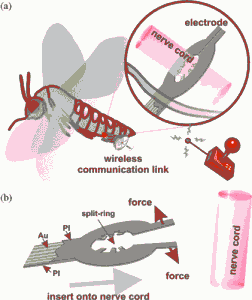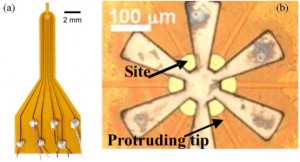Flexible Multi-functional Electrodes for Neural Interfacing
- Category: MEMS & BioMEMS
- Tags: aalap dighe, joel voldman
Interfaces with the nervous system are important for understanding basic neurobiology and for neuromedicine. We are part of a multi-university NSF Engineering Research Center (ERC) focused on sensorimotor neural engineering. One of the challenges that our team is addressing is making multi-functional interfaces with the nervous system. This work builds upon a previous collaboration developing flexible multi-site electrodes (FME) for insect flight control that directly interfaced with the animal’s central nervous system (Figure 1). The FMEs are made of two layers of polyimide with gold sandwiched in between in a split-ring geometry using standard MEMS processing (Figure 2) [1] . The FMEs have a novel split-ring design that incorporates the anatomical bi-cylinder structure of the nerve cord of the moth Manduca Sexta. Additionally, we integrated carbon nanotube (CNT)-Au nanocomposites into the FMEs to enhance the charge injection capability of the electrode.
As part of the NSF ERC, we are working with collaborators to extend this work by integrating the latest knowledge on electrode design into the probes. We are also investigating addition of multi-functionality to the probes, for example integrating both sensing and actuation modalities onto the same device. This integration would allow closed-loop operation of the probes, which we believe will have applicability both to uncover the basic mechanisms behind neurological disorders as well as to serve as eventual “smart” therapeutic devices.
- Figure 1: (a) Schematic of a moth with an inserted FME. (b) Detailed schematic of the FME.
- Figure 2: (a) Image of the FME with color-coded wire connections. (b) Close-up image of the FME at the split-ring region.
- W. M. Tsang, A. Stone, Z. Aldworth, D. Otten, T. Akinwande, T. Daniel, J. G. Hildebrand, R. Levine, and J. Voldman, “Remote control of a cyborg moth using carbon nanotube-enhanced flexible neuroprosthetic probe,” in Proc. IEEE MEMS, 2010, pp. 39-42. [↩]

